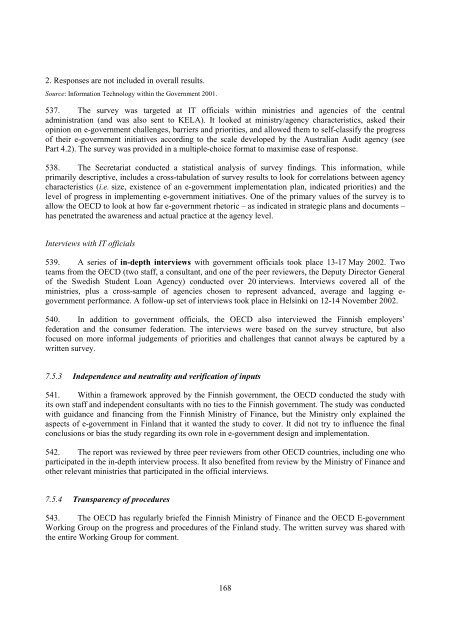e-GOVERNMENT IN FINLAND - ePractice.eu
e-GOVERNMENT IN FINLAND - ePractice.eu
e-GOVERNMENT IN FINLAND - ePractice.eu
Create successful ePaper yourself
Turn your PDF publications into a flip-book with our unique Google optimized e-Paper software.
2. Responses are not included in overall results.<br />
Source: Information Technology within the Government 2001.<br />
537. The survey was targeted at IT officials within ministries and agencies of the central<br />
administration (and was also sent to KELA). It looked at ministry/agency characteristics, asked their<br />
opinion on e-government challenges, barriers and priorities, and allowed them to self-classify the progress<br />
of their e-government initiatives according to the scale developed by the Australian Audit agency (see<br />
Part 4.2). The survey was provided in a multiple-choice format to maximise ease of response.<br />
538. The Secretariat conducted a statistical analysis of survey findings. This information, while<br />
primarily descriptive, includes a cross-tabulation of survey results to look for correlations between agency<br />
characteristics (i.e. size, existence of an e-government implementation plan, indicated priorities) and the<br />
level of progress in implementing e-government initiatives. One of the primary values of the survey is to<br />
allow the OECD to look at how far e-government rhetoric – as indicated in strategic plans and documents –<br />
has penetrated the awareness and actual practice at the agency level.<br />
Interviews with IT officials<br />
539. A series of in-depth interviews with government officials took place 13-17 May 2002. Two<br />
teams from the OECD (two staff, a consultant, and one of the peer reviewers, the Deputy Director General<br />
of the Swedish Student Loan Agency) conducted over 20 interviews. Interviews covered all of the<br />
ministries, plus a cross-sample of agencies chosen to represent advanced, average and lagging egovernment<br />
performance. A follow-up set of interviews took place in Helsinki on 12-14 November 2002.<br />
540. In addition to government officials, the OECD also interviewed the Finnish employers’<br />
federation and the consumer federation. The interviews were based on the survey structure, but also<br />
focused on more informal judgements of priorities and challenges that cannot always be captured by a<br />
written survey.<br />
7.5.3 Independence and n<strong>eu</strong>trality and verification of inputs<br />
541. Within a framework approved by the Finnish government, the OECD conducted the study with<br />
its own staff and independent consultants with no ties to the Finnish government. The study was conducted<br />
with guidance and financing from the Finnish Ministry of Finance, but the Ministry only explained the<br />
aspects of e-government in Finland that it wanted the study to cover. It did not try to influence the final<br />
conclusions or bias the study regarding its own role in e-government design and implementation.<br />
542. The report was reviewed by three peer reviewers from other OECD countries, including one who<br />
participated in the in-depth interview process. It also benefited from review by the Ministry of Finance and<br />
other relevant ministries that participated in the official interviews.<br />
7.5.4 Transparency of procedures<br />
543. The OECD has regularly briefed the Finnish Ministry of Finance and the OECD E-government<br />
Working Group on the progress and procedures of the Finland study. The written survey was shared with<br />
the entire Working Group for comment.<br />
168
















